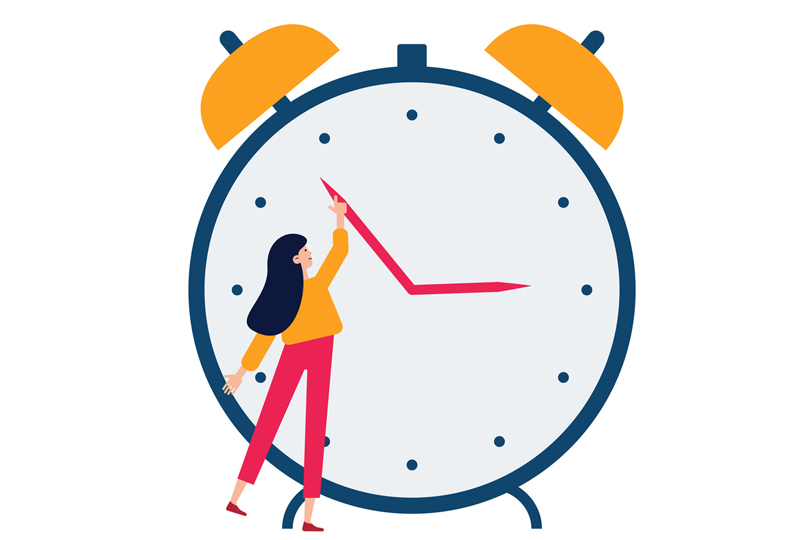Clocks will spring forward one hour this Sunday, March 9, 2025. Here’s how you can start make adjustments today…Because losing an hour of sleep shouldn’t mean losing your glow…
Twice a year, the clocks shift and, somehow, so does our entire equilibrium. This Sunday, we “spring forward,” surrendering an hour of our precious sleep to the chaos that is daylight saving time (DST). And if you’ve ever found yourself feeling groggy, sluggish, or just off in the days that follow, you’re not imagining things. The one-hour time shift may seem small, but its impact can feel colossal—especially for women, who already face hormonal fluctuations, sleep cycle disruptions, and the general mental load of, well, everything.
But fear not. With a little foresight (and a few strategic tweaks to your routine), you can ease into the transition *gracefully*—no under-eye bags required. Here’s how to adjust for daylight saving time like a pro.
1. Shift your bedtime—starting tonight
Suddenly going to bed an hour earlier on Saturday night? Not happening. Instead, ease into DST by adjusting your bedtime gradually over a few days. Move your bedtime (and wake-up time) 15 minutes earlier each night leading up to the time change. By Sunday, your body will already be partially adjusted—making Monday morning far less brutal.
Pro tip: Set a “wind-down alarm” an hour before your new bedtime to remind yourself to disconnect from screens, dim the lights, and start your nighttime ritual.
2. Prioritize morning light exposure
Sunlight is the ultimate circadian rhythm reset button. To combat grogginess from the lost hour, get outside early in the morning—yes, even if it’s overcast. Morning light exposure tells your brain it’s time to wake up, helping regulate melatonin levels and boosting energy naturally.
No time for a morning walk? Open your curtains the moment you wake up or invest in a sunrise-simulating alarm clock to mimic natural light.
3. Adjust your caffeine and evening routine
We love a good oat milk latte as much as the next girl, but caffeine too late in the day can seriously mess with your sleep schedule. Avoid caffeine after 2 p.m. to give your body enough time to process it before bedtime.
And while we’re on the subject of evening habits: Keep late-night scrolling to a minimum. Blue light from screens delays melatonin production, making it harder to fall asleep—especially when your body is already adjusting to a new schedule. Opt for a book, a warm bath, or a few minutes of deep breathing instead.
4. Nourish your body the right way
What you eat (and when you eat) can impact how smoothly you transition into DST. Try these small but effective dietary shifts:
✔ Eat a protein-rich breakfast to help stabilize energy levels.
✔ Avoid heavy dinners too close to bedtime, which can disrupt digestion and make it harder to fall asleep.
✔ Hydrate, hydrate, hydrate—dehydration can amplify fatigue and brain fog.
5. Supplement smartly
If you struggle with sleep disruptions, the right supplements can be a game-changer. Consider:
- Magnesium: Helps relax your muscles and calm your nervous system before bed.
- Melatonin: A low dose (0.5-1mg) can help ease the transition, but it’s best used temporarily.
- Vitamin D: Essential for energy levels and circadian rhythm regulation, especially as we adjust to longer days.
6. Give yourself a sleep grace period
Let’s be real: The first few mornings post-DST are not the time for 6 a.m. spin class. Give your body permission to adjust. If possible, avoid early meetings on Monday, and keep your workouts moderate rather than intense. Listen to your body and ease into the week with a little extra kindness.
7. Make Self-Care Non-Negotiable
Sleep disruptions can affect everything—your mood, skin, energy levels, even hormone balance. Prioritizing self-care in the days following DST isn’t indulgent; it’s necessary. Try:
- Facial massage or gua sha to depuff tired skin.
- An evening bath with Epsom salts to relax your muscles and promote deeper sleep.
- Journaling or meditation before bed to quiet a racing mind.
The Bottom Line: Be Gentle with Yourself
Daylight saving time can be disruptive, but it doesn’t have to derail your routine. With a little planning and a lot of self-compassion, you can glide through the transition—no caffeine crashes or mood swings required. So set those clocks forward and embrace the longer, sunlit days ahead.
Because adjusting to daylight saving time? That’s just another reason to prioritize you.











